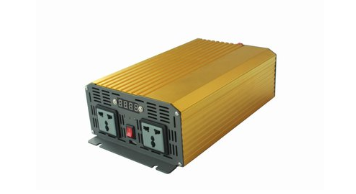The main component of the inverter system is the battery, which provides direct current to the inverter. Household inverters use maintenance-free batteries (made by flat-plate current collectors that do not require water injection), and the backup time of the inverter depends on the battery capacity. The rating of the inverter is VA (volt-ampere). 500 VA, 800 VA, 1000 VA, etc. are common household inverters. The small inverter is to convert the direct current (du12V, 24V battery voltage) into 110V or 220V AC voltage. It should be used urgently when the household electrical appliances are powered off. When the grid has electricity, the inverter will The 220V becomes DC 12V or 24V to charge the battery, and then the battery 12V or 24V battery voltage is converted to 220V AC when the power is out.

The inverter first converts AC to DC to charge the battery, and then converts DC to AC to power the electric equipment. There are various types of inverters on the market, the most efficient of which is a pure sine wave inverter, which produces alternating current similar to a household waveform power supply.
It should be selected according to the electrical appliances and power used. The battery voltage must be consistent with the nominal DC input voltage of the inverter. If it is only used for domestic lighting, this load type is a resistive load, and a non-sine wave inverter can meet the demand; if it is an inductive load such as a fan or a TV, then a sine wave inverter should be used.
When the power of the inverter reaches more than 1000VA, it can be used for industrial purposes such as communication base stations and equipment rooms.
The output power of the inverter must be greater than the maximum power of the consumer; especially for some devices with large starting energy requirements, such as motors and air conditioners, additional power margins are required.
The positive and negative poles must be wired correctly. The DC voltage connected to the inverter is marked with positive and negative poles. Under normal circumstances, red is positive (+), black is negative (-), the battery is also marked with positive and negative, red is positive (+), black is negative (-), and must be positively connected (red to red) when connected ), negative to negative (black to black). The diameter of the connecting wire must be thick enough, and the length of the connecting wire should be reduced as much as possible.
The charging process and the inverter process cannot be performed at the same time to avoid damaging the equipment and causing malfunctions.
The inverter housing should be properly grounded to avoid personal injury due to electrical leakage.
To avoid electric shock, non-professionals are strictly prohibited to disassemble, repair, or modify the inverter.
Try to increase the power generation of each inverter power module and track the maximum power. Due to the tracking of the maximum power point of a single module, the power generation of the photovoltaic system can be greatly increased by 25%.
By adjusting the voltage and current of each row of photovoltaic panels until they are all balanced to avoid system mismatch.
Each module has a monitoring function to reduce the maintenance cost of the system, and the operation is more stable and reliable.
Flexible configuration, in the home market, the size of photovoltaic cells can be installed according to the user's financial resources.
No high-voltage electricity, safer, simple and faster installation, low maintenance and installation costs, less dependence on installation service providers, so that the solar power generation system can be DIYed by users.
The cost is comparable to that of a centralized inverter, or even lower.
First, when converting a DC into an AC sine wave, it is necessary to use a power semiconductor circuit to switch the DC. At this time, the power semiconductor heat will cause a loss, but by improving the design of the switching circuit, this loss Reduces to the minimum.
Second, rely on inverter control experience to improve efficiency. The output current and voltage of the solar panel will change with the sunshine and temperature, and the inverter can optimally control the current and voltage to achieve the maximum amount of power, that is, the shortest time to find the best Powerpoint, the higher the conversion efficiency. The control characteristics of the inverter will vary depending on the products of various manufacturers, and its conversion efficiency will also be different.
Therefore, when selecting the inverter, it is necessary to consider the matching with the output characteristics of the installed solar panel.